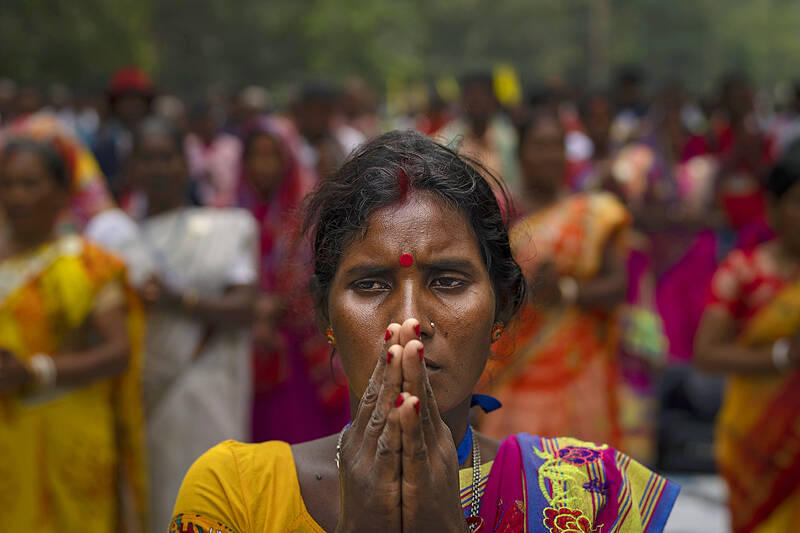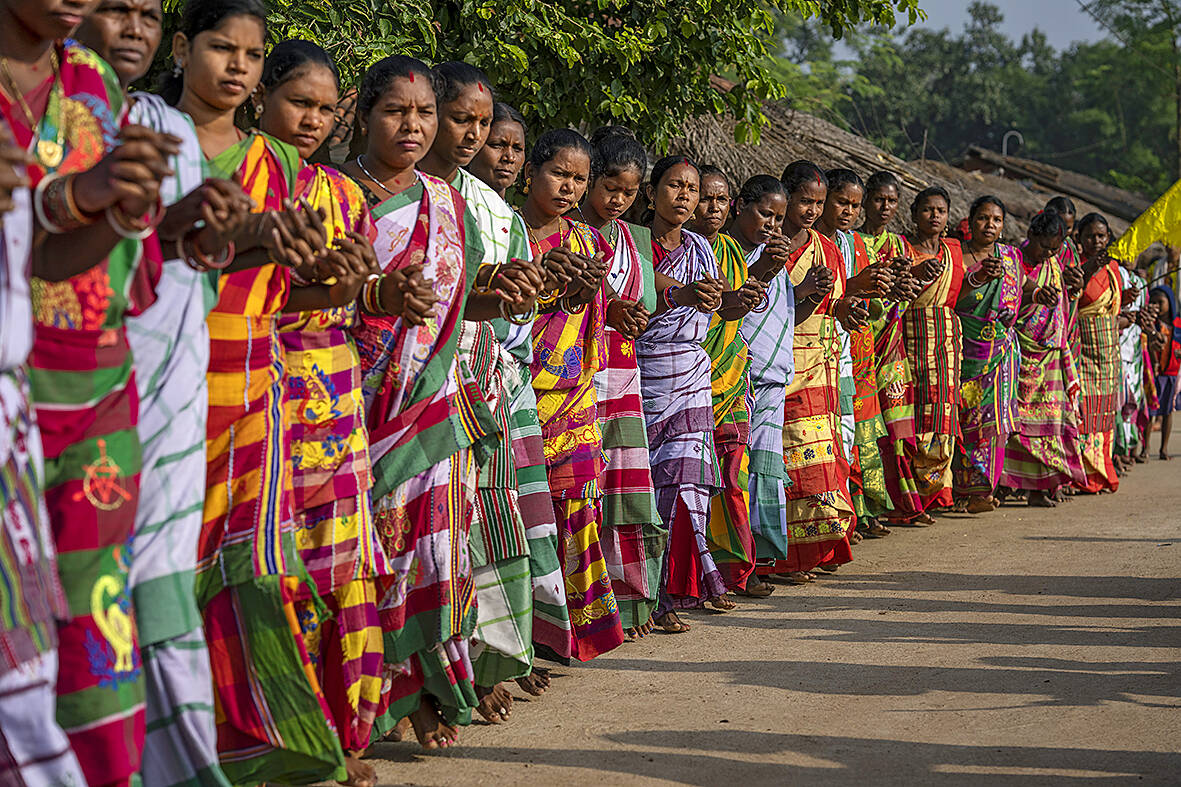The ritual began with a thunderous roll of drums that echoed throughout the village. Women in colorful saris broke into an indigenous folk dance, moving their feet to its galloping rhythm.
At the climax, 12 worshippers — proudly practicing a faith not officially recognized by the government — emerged from a mud house and marched toward a sacred grove believed to be the home of the village goddess. Led by village chieftain Gasia Maranda, they carried religious totems, including an earthen pitcher and a sacrificial ax.
Maranda and others in Guduta, a remote tribal village in India’s eastern Odisha state, are “Adivasis,” or indigenous tribespeople, who adhere to Sarna Dharma, a belief system that shares common threads with many ancient nature-worshipping religions.

Photo: AP
On that day inside the grove, worshippers displayed their reverence for the natural world, making circles around a Sal plant and three sacred stones, one each for the malevolent spirits they believe need pleased. They knelt as Maranda smeared the stones with vermillion paste, bowed to the sacred plant and laid down fresh leaves covered in a cow dung paste.
“Our Gods are everywhere. We see more in nature than others,” said Maranda.
But the government does not legally acknowledge their faith — a fact that is becoming a rallying point for change for some of the 5 million or so Indigenous tribespeople in India who follow Sarna Dharma. They say formal recognition would help preserve their culture and history in the wake of the slow erosion of Indigenous tribespeople’s rights.

Photo: AP
Citizens are only allowed to align themselves with one of the six officially recognized religions — Hinduism, Buddhism, Christianity, Islam, Jainism and Sikhism. While they can select the “Others” category, many nature worshippers have felt compelled by the religious affiliation system to associate with one of the named faiths.
PROTESTS
Tribal groups have held protests in support of giving Sarna Dharma official religion status ahead of the upcoming national census, which has citizens state their religious affiliation.

Photo: AP
The protests have gained momentum after the recent election of Droupadi Murmu, the first tribal woman to serve as India’s president, raising hopes of favorable change for the Indigenous population. They number about 110 million, according to the census. They are scattered across India and fragmented into hundreds of clans, with different legends, languages and words for their gods — many, but not all follow Sarna Dharma.
Salkhan Murmu, a former lawmaker and community activist who adheres to Sarna Dharma, is at the center of the protests pushing for government recognition. His sit-in demonstrations in several states have drawn thousands.
At a recent protest in Ranchi, the capital of eastern Jharkhand state, demonstrators sat cross-legged on a highway blocking traffic as Murmu spoke from a nearby stage and explained how anxieties over losing their religious identity and culture are driving the demand for recognition.
“This is a fight for our identity,” Murmu told the crowd, who held their fists in the air and shouted: “Victory to Sarna Dharma.”
Murmu is taking his campaign into remote tribal villages. His message: If Sarna Dharma disappears, one of the country’s last links to its early inhabitants goes with it. It is a convincing argument evidenced by the increasing number of tribal members rallying behind him.
“If our religion will not get recognized by the government, I think we will wither away,” said Murmu, as a group of villagers huddled around him in Odisha’s Angarpada village.
Murmu’s efforts are just the latest push for official recognition.
In 2011, a government agency for indigenous tribespeople asked the federal government to include Sarna Dharma as a separate religion code in that year’s census. In 2020, the Jharkhand state, where tribespeople make up nearly 27 percent of the population, passed a resolution with a similar objective.
The federal government did not respond to either request.
One argument for granting Sarna Dharma recognition is the size of the nature worshipper population, said Karma Oraon, an anthropologist who taught at Ranchi University and has studied Indigenous tribes for decades.
The 2011 census shows more than half — a number close to 4.9 million — of those who selected the “Others” religion option identified as Sarna Dharma adherents. Comparably, India’s Jain population — officially the country’s sixth largest faith group — is slightly more than 4.5 million people.
Decades ago, there were more options for indigenous tribespeople.
The census, started in 1871 under British rule, once allowed for the selection of “Animists,” “Aboriginal” and “Tribes.” The categories were removed in 1951 when the first census in independent India occurred.
‘IDENTITY CRISIS’
Some hope giving Sarna Dharma official status could stem their faith’s existential threats, ranging from migration to religious conversions.
“We are going through an identity crisis,” said Oraon.
His concerns have heightened after Hindu nationalist groups, including Prime Minister Narendra Modi’s ruling party, have sought to bring nature worshippers into the Hindu fold. These efforts stem from a long-held belief that India’s indigenous tribespeople are originally Hindus, but adherents of Sarna Dharma say their faith is different from monotheistic and polytheistic ones.
Sarna Dharma has no temples and scriptures. Its adherents don’t believe in heaven or hell and don’t have images of gods and goddesses. Unlike Hinduism, there is no caste system nor rebirth belief.
“Tribespeople might share some cultural ties with Hindus, but we have not assimilated into their religion,” said Oraon.
The gradual embrace of Hindu and Christian values by some indigenous tribal groups has exacerbated his concerns.
In the late 19th century, many tribespeople in Jharkhand, Odisha and other states renounced nature worship — some voluntarily and others coaxed by money, food and free education — and converted to Christianity. Hindu and Muslim missionaries also chipped away at their numbers.
Most Christian missionaries are met with resistance these days, but conversions can still happen. However, for Sukhram Munda, a man in his late 80s, much is already gone.
He is the great-grandson of Birsa Munda, a 19th-century charismatic Indigenous leader who led his forest-bound community in revolt against British colonialists. Munda’s legend grew after his death and statues of him appeared in almost every tribal village in the state. Soon, a man who worshipped nature was worshipped by his own people.
But Munda’s religion barely survived conversions in his ancestral Ulihatu village in Jharkhand. Half of his descendants became Christians, Sukhram said. Now, the first thing visitors see is a church, a large white building that stands out against the green of the surrounding forests.
“This used to be the village where we worshipped nature,” said Sukhram. “Now half of the people don’t even remember the religion their ancestors followed.”

On April 26, The Lancet published a letter from two doctors at Taichung-based China Medical University Hospital (CMUH) warning that “Taiwan’s Health Care System is on the Brink of Collapse.” The authors said that “Years of policy inaction and mismanagement of resources have led to the National Health Insurance system operating under unsustainable conditions.” The pushback was immediate. Errors in the paper were quickly identified and publicized, to discredit the authors (the hospital apologized). CNA reported that CMUH said the letter described Taiwan in 2021 as having 62 nurses per 10,000 people, when the correct number was 78 nurses per 10,000

As we live longer, our risk of cognitive impairment is increasing. How can we delay the onset of symptoms? Do we have to give up every indulgence or can small changes make a difference? We asked neurologists for tips on how to keep our brains healthy for life. TAKE CARE OF YOUR HEALTH “All of the sensible things that apply to bodily health apply to brain health,” says Suzanne O’Sullivan, a consultant in neurology at the National Hospital for Neurology and Neurosurgery in London, and the author of The Age of Diagnosis. “When you’re 20, you can get away with absolute

May 5 to May 11 What started out as friction between Taiwanese students at Taichung First High School and a Japanese head cook escalated dramatically over the first two weeks of May 1927. It began on April 30 when the cook’s wife knew that lotus starch used in that night’s dinner had rat feces in it, but failed to inform staff until the meal was already prepared. The students believed that her silence was intentional, and filed a complaint. The school’s Japanese administrators sided with the cook’s family, dismissing the students as troublemakers and clamping down on their freedoms — with

As Donald Trump’s executive order in March led to the shuttering of Voice of America (VOA) — the global broadcaster whose roots date back to the fight against Nazi propaganda — he quickly attracted support from figures not used to aligning themselves with any US administration. Trump had ordered the US Agency for Global Media, the federal agency that funds VOA and other groups promoting independent journalism overseas, to be “eliminated to the maximum extent consistent with applicable law.” The decision suddenly halted programming in 49 languages to more than 425 million people. In Moscow, Margarita Simonyan, the hardline editor-in-chief of the